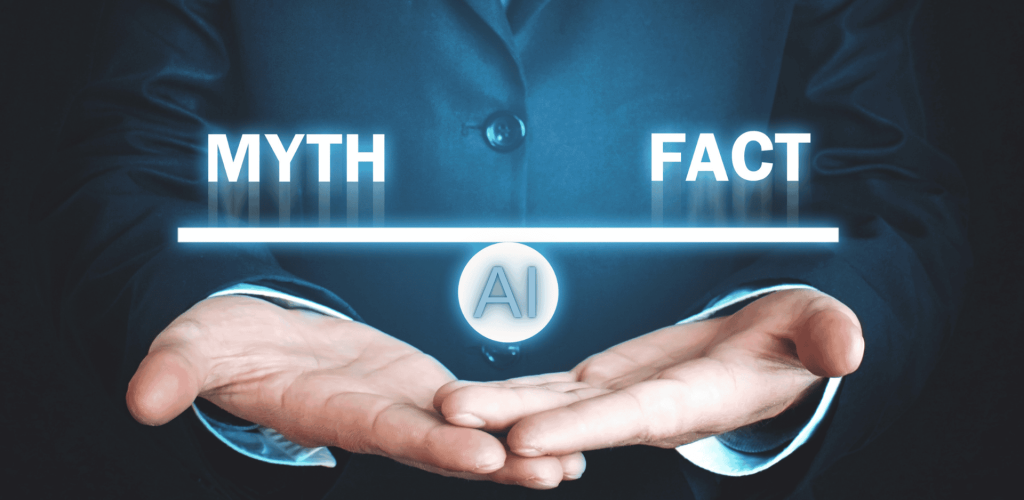
Common Myths About AI (and the Truth Behind Them)
Artificial Intelligence (AI) is one of the most talked-about technologies of our time — and also one of the most misunderstood.
From killer robots to job-stealing machines, AI myths are everywhere. But how much of what you’ve heard is actually true?
In this blog, we’ll bust the most common myths about AI and reveal the facts you really need to know.

✅ Myth 1: AI Can Think Like Humans
❌ The Myth:
AI has emotions and thinks just like a human brain.
✔ The Truth:
AI does not have emotions, self-awareness, or consciousness. It processes data and makes predictions based on patterns — not feelings or understanding.
Example:
ChatGPT can write a poem about love, but it doesn’t feel love. It simply learned patterns from text written by humans.
✅ Myth 2: AI Will Steal All Human Jobs
❌ The Myth:
AI will take over and leave humans unemployed.
✔ The Truth:
AI is replacing some repetitive jobs, but it’s also creating new roles — especially in areas like AI development, data analysis, robotics, and ethics.
Example:
Cashier roles may be replaced by self-checkout, but AI creates demand for engineers, data scientists, and machine learning trainers.
💡 Fact:
The World Economic Forum predicts AI will create millions more jobs than it eliminates.
✅ Myth 3: AI Is Always Right
❌ The Myth:
AI systems are perfect and unbiased.
✔ The Truth:
AI can make mistakes and inherit biases from the data it’s trained on. It reflects the quality and diversity of its training data.
Example:
An AI used in hiring may favor certain candidates over others if trained on biased historical hiring data.
Takeaway:
AI is a tool, not a flawless decision-maker. Human oversight is essential.
✅ Myth 4: AI Works Like Magic
❌ The Myth:
AI is a mysterious black box that can solve any problem.
✔ The Truth:
AI has limitations. It needs huge amounts of data, works best in narrow tasks, and requires careful programming and training.
Example:
AI can beat world champions at chess but still fail to recognize sarcasm in a casual conversation.
✅ Myth 5: AI and Robots Are the Same
❌ The Myth:
AI equals robots. All AI exists inside a robot body.
✔ The Truth:
Most AI today lives in software, not robots. AI powers things like Google Search, Netflix recommendations, and ChatGPT — without any physical body.
Example:
You interact with AI every time you use your smartphone — no robot involved!
✅ Myth 6: AI Will Take Over the World
❌ The Myth:
AI will become super-intelligent and dominate humanity (like in sci-fi movies).
✔ The Truth:
There is no AI today that comes close to being self-aware or independently powerful. All AI systems are controlled by humans, with clear limitations and guardrails.
Example:
Even advanced tools like ChatGPT have no goals or desires. They can’t make decisions unless we design them to.
✅ Myth 7: You Need to Be a Genius to Understand AI
❌ The Myth:
Only scientists or programmers can understand or work with AI.
✔ The Truth:
Anyone can learn the basics of AI. Tools like ChatGPT and Canva’s AI features are designed for everyday use by non-coders.
Example:
Small business owners use AI to write emails, edit images, and automate tasks — no coding required!
🙋♂️ FAQs
Q1: Can AI make moral decisions?
No. AI doesn’t understand ethics or values — it makes decisions based on data and algorithms.
Q2: Can I use AI even if I don’t code?
Absolutely. Tools like ChatGPT, Canva AI, Notion AI, and Grammarly are designed for non-programmers.
Q3: What’s the most important thing to remember about AI?
AI is a tool created and controlled by humans — not a replacement for human judgment.
🧠 Final Thoughts
AI is powerful, but it’s not magic, human, or unstoppable. The more you understand about AI, the less mysterious — and more useful — it becomes.
By separating fact from fiction, we can use AI responsibly, effectively, and ethically in our everyday lives.
